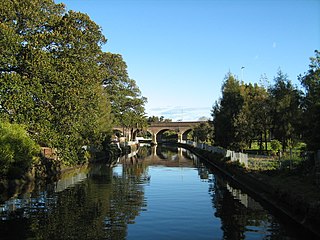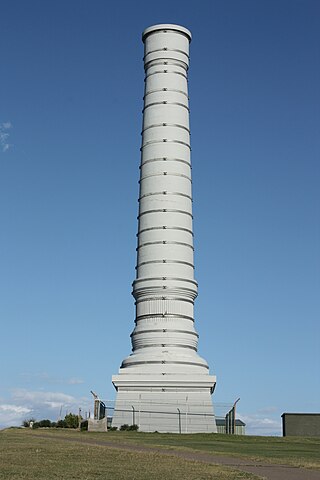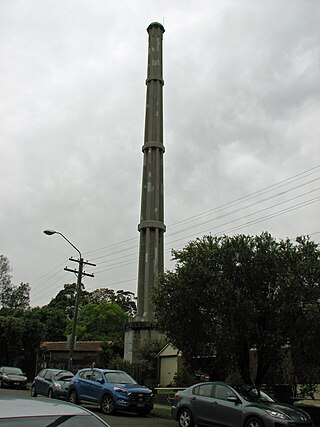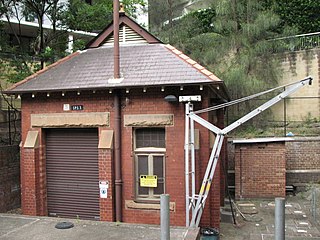
Whites Creek, formerly known as White's Creek, was once a natural waterway that was concreted to improve sanitation. The creek is now a heritage–listed artificial waterway located in the inner–west region of Sydney, New South Wales, Australia.

Johnstons Creek, formerly Johnston's Creek, is an urban gully, located in Sydney, Australia and situated in the Inner West and Sydney local government areas. The creek flows from Petersham, past Annandale, Camperdown, Forest Lodge and Harold Park, before spilling into Rozelle Bay, within Sydney Harbour.

Monier Ventilation Shaft 3 is a heritage-listed ventilation shaft at Florence Street, Teneriffe, City of Brisbane, Queensland, Australia. It was designed by Joseph Monier and built c. 1904. It was added to the Queensland Heritage Register on 4 August 1998.

The Barwon Sewer Aqueduct is a heritage-listed aqueduct across the Barwon River at Goat Island, Breakwater, Victoria, Australia. It was designed by engineer E. G. Stone and was erected between 1913-1915. It would appear to be the only one of its kind in Australia in terms of its length and the use of Considère's construction technique. The aqueduct appears to be the last example in Australia of Armand Considère's system of reinforcing for concrete structures. It was added to the Victorian Heritage Register on 23 October 1991.

Monier Ventilation Shaft 1 is a heritage-listed ventilation shaft at 500 Wickham Terrace, Spring Hill, City of Brisbane, Queensland, Australia. It was designed by Joseph Monier and built c. 1904. It was added to the Queensland Heritage Register on 4 August 1998.

Monier Ventilation Shaft 2 is a heritage-listed ventilation shaft at 134 St Paul's Terrace, Spring Hill, City of Brisbane, Queensland, Australia. It was designed by Joseph Monier and built c. 1904. It was added to the Queensland Heritage Register on 4 August 1998.

Lewisham Sewage Aqueduct is a heritage-listed sewage aqueduct in Gadigal Reserve, adjacent to 5 Grosvenor Crescent, Summer Hill, Inner West Council, Sydney, New South Wales, Australia. It was designed by Sewerage Construction Branch and Department of Public Works and built in 1900. The property is owned by Sydney Water. It was added to the New South Wales State Heritage Register on 18 November 1999.
The Middle Harbour Syphon is a heritage-listed sewerage syphon located at Monash Crescent, Clontarf, Northern Beaches Council, New South Wales, Australia. It was designed by E. M. de Burgh, an engineer in the NSW Public Works Department and was built from 1922 to 1925 by the Department. The sewerage syphon is also known as the Middle Harbour Syphon NSOOS and The Spit Syphon. The property is owned by Sydney Water, an agency of the Government of New South Wales. The property was added to the New South Wales State Heritage Register on 15 November 2002.

The Bondi Sewer Vent is a heritage-listed sewer vent shaft located at Military Road, North Bondi, Sydney, Australia. It was designed by the Metropolitan Board of Water Supply and Sewerage. It is also known as Sewer Vent (Ben Buckler), Ben Buckler and Earlier brick vent. The property is owned by Sydney Water.
The Bondi Ocean Outfall Sewer is a heritage-listed sewerage infrastructure at Blair Street, North Bondi, Sydney, Australia. The sewer line commences at the intersection of Oxford Street and College Street in Darlinghurst and then travels in a more-or-less easterly direction for 6.1 kilometres (3.8 mi) passing through a number of suburbs until it reaches Blair Street in North Bondi. It was designed and built by the Public Works Department between 1880 and 1889. It is also known as BOOS (Bondi Ocean Outfall Sewer) and Main Northern Ocean Outfall Sewer. The property is owned by Sydney Water.

Western Outfall Main Sewer is a heritage-listed former sewage farm outfall sewer and now ocean outfall sewer near Valda Avenue, Arncliffe, Bayside Council, New South Wales, Australia. It was designed by the New South Wales Department of Public Works, who built the sewer from 1895 to 1898. It is also known as SWSOOS No. 1, Western Main Carrier and Western Main Outfall Sewer. The property is owned by Sydney Water. It was added to the New South Wales State Heritage Register on 15 November 2002.

The Cooks River Sewage Aqueduct is a heritage-listed sewage aqueduct located at Pine Street, Earlwood, New South Wales, Australia. It crosses the Cooks River to Thornley Street, Marrickville. It was designed by Sewerage Construction Branch and NSW Department of Public Works and built during 1895 by J. F. Carson, contractor. The property is owned by Sydney Water, an agency of the Government of New South Wales. It was added to the New South Wales State Heritage Register on 18 November 1999.

The Wolli Creek Aqueduct is a heritage-listed sewage aqueduct located at Unwin Street, Earlwood, City of Canterbury-Bankstown, New South Wales, Australia.

The Mosman Bay Sewage Aqueduct is a heritage-listed public pedestrian bridge and sewage aqueduct at Avenue Road, Mosman in the Mosman Council local government area of New South Wales, Australia. It was designed by Sewerage Construction Branch and NSW Department of Public Works and built from 1899 to 1901 by NSW Department of Public Works. It is also known as the Aqueduct over Mosman Bay. The property is owned by Sydney Water, an agency of the Government of New South Wales. It was added to the New South Wales State Heritage Register on 18 November 1999.

White's Creek Aqueduct is a heritage-listed sewage aqueduct at Piper Street, Lilyfield, Inner West Council, Sydney, New South Wales, Australia. It was designed by engineer William Julius Baltzer of the New South Wales Public Works Department and built by the Department from 1897 to 1898. The property is owned by Sydney Water. It was added to the New South Wales State Heritage Register on 18 November 1999.

The Burwood Sewer Vent is a heritage-listed sewer ventilation stack located at Railway Parade in the Sydney suburb of Burwood, New South Wales, Australia. It was designed and built by the Metropolitan Board of Water Supply and Sewerage in 1919. It is also known as Wentworth Road Sewer Vent and Railway Parade Sewer Vent. The property is owned by Sydney Water, a statutory corporation of the Government of New South Wales. It was added to the New South Wales State Heritage Register on 15 November 2002.

The Croydon Sewer Vent is a heritage-listed sewer ventilation stack located on a small parcel of land adjacent to 12 Paisley Road, Croydon, New South Wales, a suburb of Sydney, Australia. It was designed and built by the Metropolitan Board of Water Supply and Sewerage in 1922. It is also known as Sewer Vent and Paisley Road Sewer Vent. The property is owned by Sydney Water, a statutory corporation of the Government of New South Wales. It was added to the New South Wales State Heritage Register on 15 November 2002.

The Ultimo Sewage Pumping Station is a heritage-listed sewerage pumping station located at William Henry Street in the inner city Sydney suburb of Ultimo in the City of Sydney local government area of New South Wales, Australia. As a result of the construction of an elevated roadway along William Henry Street, the pumping station now fronts Pyrmont Street, with vehicles being required to enter via Quarry Street, then turning right into Pyrmont Street.

The Rushcutters Bay Sewage Pumping Station is a heritage-listed sewerage pumping station located at Rushcutters Bay Park in the inner city Sydney suburb of Rushcutters Bay in the City of Sydney local government area of New South Wales, Australia. It was designed and built by the New South Wales Public Works Department from 1902 to 1904. It is also known as Sewage Pumping Station 18 and SPS 18. The property is owned by Sydney Water. It was added to the New South Wales State Heritage Register on 18 November 1999.

Sewage Pumping Station 3 is a heritage-listed sewerage pumping station located near 1 Booth Street, Annandale, City of Sydney, New South Wales, Australia. The building is located adjacent to Johnstons Creek. It was built from 1902 to 1904 by the New South Wales Public Works Department. It is also known as SPS 3, SP0003, Booth Street Sewage Pumping Station and Annandale Sewage Pumping Station. The property is owned by Sydney Water. It was added to the New South Wales State Heritage Register on 18 November 1999.






















